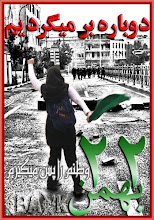I'm shocked to find it's more than a month since I wrote for this blog. Much has happened. I've been in Iran, discussing a planned solo show in Esfahan in 2009, in the Iranian month of Ordibehesht, which runs from April 21st - May 21st. There will be much more on this soon, and more about plans for The C Word's second year, which, coincidentally starts at about the same time as Iranian New Year, mid - March.
Meanwhile, I want to tell you about a remarkable, ambitious, and to the best of my knowledge, unique exhibition I saw on Sunday 14th December, the last day of it's two-week run.
Viva Viva
In a giant concrete bunker under the Marylebone campus of the University of Westminster, opposite Baker st. Tube Station and Madame Tussaude’s, lies P3. It’s one of London’s newest art spaces, and certainly one of its biggest. If Tate modern resembles an airport, (which it does), this is the aircraft hanger. It’s brutal though, the sort of place that General Pinochet would have singled out for particularly ghastly torture sessions.
Undaunted, however, the turbo-charged visionary that is Zemirah Moffat, spun into action and delivered an astonishing exhibition of flickering, glittering screens, colour bars, soundscapes, language trails and lovingly bound, printed volumes, all in the service of the practice-based PhDs in Audio-visual media.
The idea itself was eccentric to the point of insanity – it would certainly have seemed so to the average, art-world curator.
‘I’m going to curate a show of practice-based PhDs in audio-visual media from the last 20 years. It’s a show about knowledge. The centre piece will be a library with all the doctoral theses bound in orange on the shelves so that the audience can read them.'
YAAH RIGHT, drawls the west-end curator, adjusting her velvet hair band, and hastily doing up the top button of her Harvey Nich’s silk blouse. A doctoral thesis sounded mildly threatening–she wasn’t going to take any risks.
YEAH RIGHT, sneers the cool cat curator, tossing his thinning mane, grease landing in a fine spray on a nearby wall – consults his blackberry, ‘we’ll just close the gallery for the two weeks it’s on shall we?’ Collapses with laughter at his own side-splitting wit.
I wont pretend it wasn’t overwhelming, intimidating almost as you descend the concrete bunker and encounter the numerous screens, but bit by bit, they separate out and become individual pieces of work. The vast space is generous, you could arrange yourself comfortably and settle into each work, absorbing the particular nature of the ‘cinema’ venue, or the tv screens, the still photographs suspended from the ceiling, or the computer screen tucked up next to a pillar, or the several screens forming a whole installation. Ear phones allowed me to sink into John Wynne’s ‘Hearing Voices’, work on click languages from the Kalahari Desert in Botswana, which attended to all my personal obsessions, and for which I would cheerfully have settled in for the night.
Screen work rarely does well in a conventional gallery space, so perhaps this most emphatically not white, not cube, demonstrates that very different kinds of spaces are needed for such work to thrive. The most significant thing though was the constant humming presence of the research, the building of knowledge through experiment and writing, the integrated relationship between the written thesis and the art work, which, probably for the first time, were allowed to appear in the same venue at the same time, so the viewer/ reader/ audience could encounter the whole, rather than the fragmented, disassociated parts. This was an extraordinary adventure which demanded much from its audience and delivered more. I’d love to see something like it in the Hayward. The public are quite capable of coping with a bit of hard-core thinking, if only we’re given the chance.
Friday, 19 December 2008
Subscribe to:
Post Comments (Atom)












































No comments:
Post a Comment